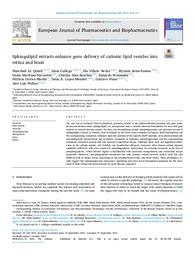Título :
Sphingolipid extracts enhance gene delivery of cationic lipid vesicles into retina and brain |
Autor :
AL Qtaish, Nuseibah
Gallego, Idoia
Villate Beitia, Ilia 
Sainz-Ramos, Myriam 
Martínez-Navarrete, Gema
Soto-Sánchez, Cristina 
Fernández, Eduardo
Galvez-Martín, Patricia
Lopez-Mendez, Tania B.
Puras, Gustavo
Pedraz, José Luis  |
Editor :
Elsevier |
Departamento:
Departamentos de la UMH::Histología y Anatomía |
Fecha de publicación:
2021-10-02 |
URI :
https://hdl.handle.net/11000/35181 |
Resumen :
The aim was to evaluate relevant biophysic processes related to the physicochemical features and gene transfection mechanism when sphingolipids are incorporated into a cationic niosome formulation for non-viral gene delivery to central nervous system. For that, two formulations named niosphingosomes and niosomes devoid of sphingolipid extracts, as control, were developed by the oil-in water emulsion technique. Both formulations and the corresponding complexes, obtained upon the addition of the reporter EGFP plasmid, were physicochemically and biologically characterized and evaluated. Compared to niosomes, niosphingosomes, and the corresponding complexes decreased particle size and increased superficial charge. Although there were not significant differences in the cellular uptake, cell viability and transfection efficiency increased when human retinal pigment epithelial (ARPE-19) cells were exposed to niosphingoplexes. Endocytosis via caveolae decreased in the case of niosphingoplexes, which showed higher co-localization with lysosomal compartment, and endosomal escape properties. Moreover, niosphingoplexes transfected not only primary central nervous system cells, but also different cells in mouse retina, depending on the administration route, and brain cortex. These preliminary results suggest that niosphingosomes represent a promising non-viral vector formulation purposed for the treatment of both retinal and brain diseases by gene therapy approach.
|
Palabras clave/Materias:
brain
gene therapy
ninosomes
niosphingosomes
retina
sphingolipids |
Tipo de documento :
info:eu-repo/semantics/article |
Derechos de acceso:
info:eu-repo/semantics/openAccess
Attribution-NonCommercial-NoDerivatives 4.0 Internacional |
DOI :
10.1016/j.ejpb.2021.09.011 |
Publicado en:
Eur J Pharm Biopharm . 2021 Dec:169:103-112 |
Aparece en las colecciones:
Artículos Histología y Anatomía
|

 La licencia se describe como: Atribución-NonComercial-NoDerivada 4.0 Internacional.
La licencia se describe como: Atribución-NonComercial-NoDerivada 4.0 Internacional.
.png)